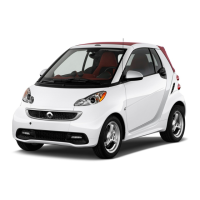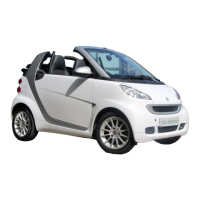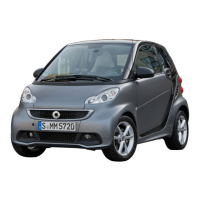G
WARNING
Pyrotechnic Emergency Tensioning Devices
that have been deployed are no longer
operational and are unable to perform
their intended protective function. This
poses an increased risk of injury or even
fatal injury.
Therefore, have pyrotechnic Emergency
Tensioning Devices which have been trig-
gered immediately replaced at a qualified
specialist workshop.
If Emergency Tensioning Devices are trig-
gered or air bags are deployed, you will hear
a bang, and a small amount of powder may also
be released. The 6 restraint system warn-
ing lamp lights up.
Only in rare cases will the bang affect your
hearing. The powder that is released gener-
ally does not constitute a health hazard, but it
may cause short-term breathing difficulties
in people with asthma or other respiratory
problems. Provided it is safe to do so, you
should leave the vehicle immediately or open
the window in order to prevent breathing dif-
ficulties.
Air bags and pyrotechnic Emergency Tension-
ing Devices (ETDs) contain perchlorate mate-
rial, which may require special handling and
regard for the environment. National guide-
lines must be observed during disposal. In
California, see www.dtsc.ca.gov/
HazardousWaste/Perchlorate/index.cfm.
Method of operation
During the first stage of a collision, the
restraint system control unit evaluates
important physical data relating to vehicle
deceleration or acceleration, such as:
R
duration
R
direction
R
intensity
Based on the evaluation of this data, the
restraint system control unit triggers the
Emergency Tensioning Devices during a fron-
tal or rear collision.
An Emergency Tensioning Device can only be
triggered, if:
R
the ignition is switched on
R
the components of the restraint system are
operational. You can find further informa-
tion under: "Restraint system warning
lamp" (
Y page 30)
R
the belt tongue has engaged in the belt
buckle of the respective seat
If the restraint system control unit detects a
more severe accident, further components of
the restraint system are activated independ-
ently of each other in certain frontal colli-
sion situations:
R
Front air bags as well as driver's and front-
passenger knee bags
R
Window curtain air bag, if the system
determines that deployment can offer
additional protection to that provided by
the seat belt
The front-passenger front air bag is activa-
ted or deactivated depending on the person on
the front-passenger seat. The front-
passenger front air bag can only deploy in an
accident if the PASSENGER AIR BAG ON indi-
cator lamp is lit. Observe the information on
the PASSENGER AIR BAG indicator lamps
(
Y page 30).
Your vehicle has two-stage front air bags.
During the first deployment stage, the front
air bag is filled with propellant gas to
reduce the risk of injuries. The front air bag
is fully deployed with the maximum amount of
propellant gas if a second deployment
threshold is reached within a few millisec-
onds.
The activation threshold of the Emergency
Tensioning Devices and the air bag are
determined by evaluating the rate of vehicle
deceleration or acceleration which occurs at
various points in the vehicle. This process is
pre-emptive in nature. Deployment should
take place in good time at the start of the
collision.
The rate of vehicle deceleration or acceler-
ation and the direction of the force are
essentially determined by:
R
the distribution of forces during the col-
lision
R
the collision angle
Occupant safety
41
>> Safety.
Z

